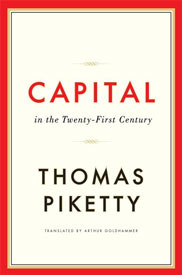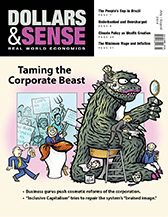
Picketing Wealth Inequality
Review of Capital in the Twenty-First Century
by Thomas Picketty. Harvard University Press, 2014.
This article is from Dollars & Sense: Real World Economics, available at http://www.dollarsandsense.org

This article is from the July/August 2014 issue.
Subscribe Now
at a 30% discount.
Great works in economics address important issues head-on, adopt a broad perspective, and change our views regarding how economies work. Make no mistake about it: Thomas Piketty’s Capital in the Twenty-First Century is a great work. As an added bonus, it is extremely well written (and translated).
Given decades of rising inequality and its negative consequences (see The Spirit Level by Richard Wilkinson and Kate Pickett and my review in the May/June 2010 issue of Dollars & Sense) and public concern about a disappearing middle class, this book is particularly timely. It relies on a wide array of data, collected by the author, showing long-term trends in income and wealth distribution. It explains the causes of these trends and ends by setting forth some bold policy solutions.
Still, the most important aspect of Capital in the Twenty-First Century is that it changes how we view the world. The following parallel might provide some historical perspective on the book, and help understand its importance and the emotional reaction it has elicited.
Thomas Malthus became one of the most controversial figures in economics following the publication of his Essay on Population in 1798. Despite much optimism at the time that ordinary people’s lives could be improved, for Malthus poverty was inevitable due to the relationship between population growth and the growth of the food supply. His Essay argued (based on some empirical data) that population growth would outstrip food supply growth, resulting in famine and misery.
Piketty can best be understood as a sort of modern-day Malthus. Both doubting Thomases sought to refute popular beliefs that life could easily be improved for most people, both used simple growth rates to do this, and both were criticized for their pessimistic conclusions.
Optimism regarding the future distribution of income stems from the work of Nobel laureate Simon Kuznets. In the 1950s, Kuznets examined U.S. income-tax data and saw income inequality improving over several decades. According to the standard interpretation of his work, he hypothesized that as capitalist economies developed, inequality first increases and then decreases. This message fit America’s economic experience during the post-war years and its geo-political needs during the Cold War. Most economists came to accept this message of hope.
But times have changed. Inequality is rising in the United States and other high-income capitalist countries. Piketty explains why economists got it wrong. He argues that greater equality between World War I and the 1960s was not part of some positive long-term trend; rather, it stemmed from a unique set of factors—two wars (that destroyed much wealth), the very high marginal tax rates implemented to pay for these wars, plus a stock-market crash and Great Depression. Starting in the 1970s or 1980s (dates differ by country) the moneyed class revolted and began to influence policy. Top income-tax rates fell; income and wealth inequality rose rapidly. As a result, we seem headed toward another Gilded Age, similar to the late 19th century, where the fabulously wealthy live charmed lives and everyone else struggles to survive.
Piketty, like Malthus, draws his dismal conclusion from the relationship between two growth rates. In Piketty’s case, they are the rate of return to wealth or capital (r) and the growth rate of the economy (g). When r exceeds g, more money flows to those at the top and inequality increases; when r is less than g, more benefits of economic growth flow to workers, making income and wealth distribution more equal.
One great virtue of Piketty’s book is that it explains why income inequality has grown of late. First, the ratio of wealth to GDP declined in Europe from 6:1 or 7:1 around World War I to 2:1 in the 1960s. It has since rebounded to nearly 6:1. The United States experienced a smaller decline, since its factories were not destroyed by the two wars, but has also experienced a growing wealth-to-GDP ratio of late. Second, r has averaged around 5% over long periods of time in many different countries, while g cannot be expected to grow by much more than 1%.
Together these results create a distribution problem, which may be easiest to comprehend in personal terms.
Suppose you receive a $200,000 inheritance (your wealth) and you make $100,000 a year. If your wealth grows at 5% per year and your wages grow by 1%, after 35 years (a typical working life) your wages would be around $140,000 and your wealth (assuming no spending down of this wealth) over $1 million. After several generations, around 100 years, your great grandchild would have labor income of $268,000 and have $25 million in capital assets. With a 5% return, their capital income ($1.25 million) would dwarf their labor income. If some income from wealth gets consumed, which is likely, this process just takes a little longer to work out. At some point wealth income will far exceed labor income.
The problem is that we don’t all begin with equal amounts of capital. Some start with large inheritances; most people begin with nothing. As a result, the incomes of the haves grow rapidly and wealth inequality soars.
Piketty’s story is far superior to standard economic explanations, such as technological change and globalization. He rightly rejects these theories because they cannot explain national differences in rising inequality—technological change and globalization should have similar impacts on all developed nations.
Compiling the data to make this case has been a heroic endeavor. Piketty uses income tax returns to get data on the share of national income going to the top 10%, the top 1%, and the top 0.1% of households. Estate tax returns enable him to estimate wealth inequality. And despite much criticism over the past few months, particularly by columnist Chris Giles in the Financial Times, substantial evidence supports Piketty’s conclusion that income and wealth inequality have risen in the United States and elsewhere since the late 20th century.
Similar to Malthus’s Essay, Piketty’s Capital contains virtually no economic theory. It does not address what determines economic growth or the return to wealth. Its dismal conclusion stems from historic trends and Piketty’s explanation of why high rates of return to wealth increase inequality.
The last part of the book discusses how to deal with rising inequality. Piketty is skeptical that institutional policies such as raising the minimum wage, or more generous spending programs, will help much. It is not that he opposes such efforts. Rather, he thinks they are inadequate when wealth is so unevenly distributed and grows rapidly. Government programs can help, but they cannot increase labor income by 5% annually over the long run.
Tax policy is all that is left (no pun intended). Piketty favors a more progressive individual income tax, with a 70% top rate. Corporations also need to be taxed based on where they pay wages so they cannot book profits to subsidiaries in low-tax countries.
These policies would reduce income inequality and slow down, but not reverse, the more pressing issue of greater wealth inequality. To deal with this latter problem, Piketty advocates an annual wealth tax, imposed at very low rates—one or two percent on wealth in excess of 1 million euros (nearly $1.4 million). And it must be a global tax, so that it cannot be escaped by moving wealth abroad.
Most critics of Capital in the Twenty-First Century noted that a global wealth tax is unlikely to happen anytime soon. Even Piketty himself recognizes that national governments are not currently ready for this—and may never be ready. Nonetheless, he argues cogently that this is all we have to mitigate wealth inequality. It is not extreme pessimism; rather, it is a moderate pessimism analogous to that in latter editions of Malthus’s Essay, which added “moral restraint” as a ray of hope that human progress might be possible.
Given the importance of this issue, I would have liked a slightly stronger case for a global wealth tax. Piketty could have pointed out that population growth rates (the problem that worried Malthus) now approach zero in most developed nations. This provides some hope that our own problems, however grim they may appear, are not intractable.
Going further, I wish Piketty concluded the book with a little fire in his soul and pushed harder for a global wealth tax. Borrowing a closing line from another major economist, he might have ended—“governments of the world unite! You have everything to gain from this change.”
Did you find this article useful? Please consider supporting our work by donating or subscribing.
